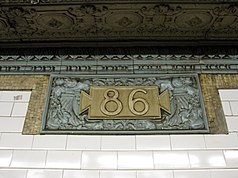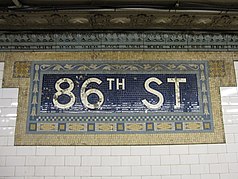86th Street station (IRT Broadway–Seventh Avenue Line)
86 Street | ||||||||||||||||||||||||||||||||||||||||||||||||||||||||||||||||||||
|---|---|---|---|---|---|---|---|---|---|---|---|---|---|---|---|---|---|---|---|---|---|---|---|---|---|---|---|---|---|---|---|---|---|---|---|---|---|---|---|---|---|---|---|---|---|---|---|---|---|---|---|---|---|---|---|---|---|---|---|---|---|---|---|---|---|---|---|---|
 Extended portion of southbound platform | ||||||||||||||||||||||||||||||||||||||||||||||||||||||||||||||||||||
| Station statistics | ||||||||||||||||||||||||||||||||||||||||||||||||||||||||||||||||||||
| Address | West 86th Street & Broadway New York, NY 10024[1] | |||||||||||||||||||||||||||||||||||||||||||||||||||||||||||||||||||
| Borough | Manhattan | |||||||||||||||||||||||||||||||||||||||||||||||||||||||||||||||||||
| Locale | Upper West Side | |||||||||||||||||||||||||||||||||||||||||||||||||||||||||||||||||||
| Coordinates | 40°47′18″N 73°58′35″W / 40.7883°N 73.9764°WCoordinates: 40°47′18″N 73°58′35″W / 40.7883°N 73.9764°W | |||||||||||||||||||||||||||||||||||||||||||||||||||||||||||||||||||
| Division | A (IRT)[2] | |||||||||||||||||||||||||||||||||||||||||||||||||||||||||||||||||||
| Line | IRT Broadway–Seventh Avenue Line | |||||||||||||||||||||||||||||||||||||||||||||||||||||||||||||||||||
| Services | 1 2 | |||||||||||||||||||||||||||||||||||||||||||||||||||||||||||||||||||
| Transit | ||||||||||||||||||||||||||||||||||||||||||||||||||||||||||||||||||||
| Structure | Underground | |||||||||||||||||||||||||||||||||||||||||||||||||||||||||||||||||||
| Platforms | 2 side platforms | |||||||||||||||||||||||||||||||||||||||||||||||||||||||||||||||||||
| Tracks | 4 | |||||||||||||||||||||||||||||||||||||||||||||||||||||||||||||||||||
| Other information | ||||||||||||||||||||||||||||||||||||||||||||||||||||||||||||||||||||
| Opened | October 27, 1904[4] | |||||||||||||||||||||||||||||||||||||||||||||||||||||||||||||||||||
| Station code | 311[5] | |||||||||||||||||||||||||||||||||||||||||||||||||||||||||||||||||||
| Opposite- direction transfer | No | |||||||||||||||||||||||||||||||||||||||||||||||||||||||||||||||||||
| Traffic | ||||||||||||||||||||||||||||||||||||||||||||||||||||||||||||||||||||
| 2019 | 5,659,795[6] | |||||||||||||||||||||||||||||||||||||||||||||||||||||||||||||||||||
| Rank | 77 out of 424[6] | |||||||||||||||||||||||||||||||||||||||||||||||||||||||||||||||||||
| Station succession | ||||||||||||||||||||||||||||||||||||||||||||||||||||||||||||||||||||
| Next north | 96th Street: 1 91st Street (closed): no service | |||||||||||||||||||||||||||||||||||||||||||||||||||||||||||||||||||
| Next south | 79th Street: 1 | |||||||||||||||||||||||||||||||||||||||||||||||||||||||||||||||||||
| ||||||||||||||||||||||||||||||||||||||||||||||||||||||||||||||||||||
| ||||||||||||||||||||||||||||||||||||||||||||||||||||||||||||||||||||
| ||||||||||||||||||||||||||||||||||||||||||||||||||||||||||||||||||||
| ||||||||||||||||||||||||||||||||||||||||||||||||||||||||||||||||||||
86th Street is a local station on the IRT Broadway–Seventh Avenue Line of the New York City Subway. Located at the intersection of West 86th Street and Broadway on the Upper West Side of Manhattan, it is served by the 1 train at all times and the 2 train during late nights.
The 86th Street station was constructed for the Interborough Rapid Transit Company (IRT) as part of the city's first subway line, which was approved in 1900. Construction of the line segment that includes the 86th Street station started on August 22 of the same year. The station opened on October 27, 1904, as one of the original 28 stations of the New York City Subway. The station's platforms have been lengthened since opening.
The 86th Street station contains two side platforms and four tracks; express trains use the inner two tracks to bypass the station. The station was built with tile and mosaic decorations, although the platform extensions contain a cinder block design. The platforms contain exits to 86th Street and Broadway and are not connected to each other within fare control.
History[]
Construction and opening[]

Planning for a subway line in New York City dates to 1864.[7]: 21 However, development of what would become the city's first subway line did not start until 1894, when the New York State Legislature authorized the Rapid Transit Act.[7]: 139–140 The subway plans were drawn up by a team of engineers led by William Barclay Parsons, chief engineer of the Rapid Transit Commission. It called for a subway line from New York City Hall in lower Manhattan to the Upper West Side, where two branches would lead north into the Bronx.[8]: 3 A plan was formally adopted in 1897,[7]: 148 and all legal conflicts concerning the route alignment were resolved near the end of 1899.[7]: 161
The Rapid Transit Construction Company, organized by John B. McDonald and funded by August Belmont Jr., signed the initial Contract 1 with the Rapid Transit Commission in February 1900,[9] in which it would construct the subway and maintain a 50-year operating lease from the opening of the line.[7]: 165 In 1901, the firm of Heins & LaFarge was hired to design the underground stations.[8]: 4 Belmont incorporated the Interborough Rapid Transit Company (IRT) in April 1902 to operate the subway.[7]: 182
The 86th Street station was constructed as part of the IRT's West Side Line (now the Broadway–Seventh Avenue Line) from 82nd Street to 104th Street, for which work had begun on August 22, 1900. Work for that section had been awarded to William Bradley.[9] The 86th Street station opened on October 27, 1904, as one of the original 28 stations of the New York City Subway from City Hall to 145th Street on the West Side Branch.[4][7]: 186
Service changes and station renovations[]
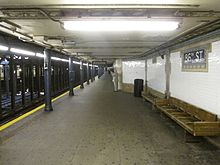
After the first subway line was completed in 1908,[10] the station was served by local trains along both the West Side (now the Broadway–Seventh Avenue Line to Van Cortlandt Park–242nd Street) and East Side (now the Lenox Avenue Line). West Side local trains had their southern terminus at City Hall during rush hours and South Ferry at other times, and had their northern terminus at 242nd Street. East Side local trains ran from City Hall to Lenox Avenue (145th Street).[11] In 1918, the Broadway–Seventh Avenue Line opened south of Times Square–42nd Street, thereby dividing the original line into an "H"-shaped system. The original subway north of Times Square thus became part of the Broadway–Seventh Avenue Line, and all local trains were sent to South Ferry.[12]
To address overcrowding, in 1909, the New York Public Service Commission proposed lengthening platforms at stations along the original IRT subway.[13]: 168 As part of a modification to the IRT's construction contracts, made on January 18, 1910, the company was to lengthen station platforms to accommodate ten-car express and six-car local trains. In addition to $1.5 million (equivalent to $41.7 million in 2020) spent on platform lengthening, $500,000 (equivalent to $13,887,500 in 2020) was spent on building additional entrances and exits. It was anticipated that these improvements would increase capacity by 25 percent.[14]: 15 Platforms at local stations, such as the 86th Street station, were lengthened by between 20 to 30 feet (6.1 to 9.1 m). Both platforms were extended to the north and south.[14]: 111
In 1927, an additional staircase was constructed from the uptown platform to the northeastern corner of 86th Street and Broadway by Patteli & Wilson for $25,300.[15][16] In 1932, the entrance at the southeastern corner of 86th Street and Broadway was relocated from the easterly curb of Broadway to the southern building line of 86th Street. The new entrance did not have a kiosk.[17]
The IRT routes were given numbered designations with the introduction of "R-type" rolling stock, which contained rollsigns with numbered designations for each service. The first such fleet, the R12, was put into service in 1948.[18] The Broadway route to 242nd Street became known as the 1 and the Lenox Avenue route as the 3.[19]
The original IRT stations north of Times Square could barely fit local trains of five or six cars depending on the configuration of the trains. Stations on the line from 50th Street to 96th Street, including this station but excluding the 91st Street station, had their platforms extended in the 1950s to accommodate ten-car trains as part of a $100 million rebuilding program.[20] The contract to extend the platforms at 79th Street and 86th Street was awarded to Delma Engineering Corporation for $1,867,705 in 1957 (equivalent to $17,210,000 in 2020).[21] The platform extensions at the local stations were completed by early 1958.[20] As part of the contract to extend the platform at this station, additional entrances were constructed.[22]
Once the project was completed, all 1 trains became local and all 2 and 3 trains became express, and eight-car local trains began operation. Increased and lengthened service was implemented during peak hours on the 1 train on February 6, 1959.[23] Due to the lengthening of the platforms at 86th Street and 96th Street, the intermediate 91st Street station was closed on February 2, 1959, because it was too close to the other two stations.[24][20]
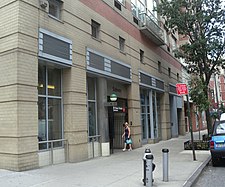
In 1985, art and mosaics were installed in the station for $200,000 (equivalent to $481,000 in 2020). The cost was covered by Haines, and was done as part of the construction of The Bromely at 85th Street and Broadway. The following year, the entrance to the southwestern corner of 87th Street and Broadway was relocated into a building, The Boulevard at 246 West 87th Street. The $1,270,000 cost of the project (equivalent to $3,056,000 in 2020) was borne by the developer, Eichner. The entrance was constructed to supplant public infrastructure improvements required by the New York City Housing Quality Program for the construction of The Boulevard, which in turn allowed the developer to increase the height of the development.[25][26]
In April 1988,[27] the New York City Transit Authority unveiled plans to speed up service on the Broadway–Seventh Avenue Line through the implementation of a skip-stop service: the 9 train.[28] When skip-stop service started in 1989, it was only implemented north of 137th Street–City College on weekdays, and 86th Street was served by both the 1 and the 9.[29][30][31] Skip-stop service ended on May 27, 2005.[32][33]
Station layout[]
| G | Street level | Exit/entrance |
| P Platform level |
Side platform | |
| Northbound local | ← ← | |
| Northbound express | ← | |
| Southbound express | | |
| Southbound local | | |
| Side platform | ||
Like other local stations, 86th Street has four tracks and two side platforms. The 1 train stops here at all times, and the 2 train stops here during late nights.[34][35] The two express tracks are used by the 2 train during daytime hours and the 3 train at all times.[36] The platforms were originally 200 feet (61 m) long, as at other local stations on the original IRT,[8]: 4 [37]: 8 but as a result of the 1958–1959 platform extension, became 520 feet (160 m) long.[20]
Design[]
As with other stations built as part of the original IRT, the station was constructed using a cut-and-cover method.[38]: 237 The tunnel is covered by a "U"-shaped trough that contains utility pipes and wires. The bottom of this trough contains a foundation of concrete no less than 4 inches (100 mm) thick.[37]: 9 Each platform consists of 3-inch-thick (7.6 cm) concrete slabs, beneath which are drainage basins. The original platforms contain circular, cast-iron Doric-style columns spaced every 15 feet (4.6 m), while the platform extensions contain I-beam columns. Additional columns between the tracks, spaced every 5 feet (1.5 m), support the jack-arched concrete station roofs.[8]: 4 [37]: 9 There is a 1-inch (25 mm) gap between the trough wall and the platform walls, which are made of 4-inch (100 mm)-thick brick covered over by a tiled finish.[37]: 9
This station retains original mosaic and terracotta wall reliefs consisting of blue trim with some "86" cornucopias. There are also a few "Men" and "Women" relief signs for now-defunct restrooms.[37]: 37 The mosaic tiles at all original IRT stations were manufactured by the American Encaustic Tile Company, which subcontracted the installations at each station.[37]: 31 The decorative work was performed by tile contractor Alfred Boote Company and faience contractor Rookwood Pottery Company.[37]: 37 The ceilings of the original platforms and fare control areas contain plaster molding.[37]: 10 At the northern part of the station, where the platforms have been extended, the walls have cream-colored tiles with a pink trim line and black "86th ST" written on them at regular intervals.[39]
The 86th Street station has artwork installed in 1989 entitled Westside Views by Nitza Tufiño. The artists are students of Manhattan Community Board 7 and the Grosvernor House. Scenes include the 72nd Street station, medians on Broadway, New York City Fire Department, children at play, Ida Straus memorial in Straus Park, boats at the 79th Street Boat Basin, Buddhist vendors on Church Street, and a New York City Bus. The station also has a poem entitled West Side Views by student Pedro Pieti.[40] Westside Views is one of two works Tufiño made for MTA Arts & Design; the other, Neo-Boriken – a solo effort – can be found at 103rd Street on the IRT Lexington Avenue Line.[41]
Exits[]
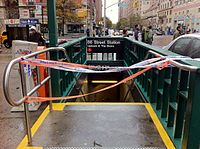
All fare control areas are on platform level and there are no crossovers or crossunders. The centers of the northbound and southbound platforms each have a fare control area with a turnstile bank and token booth, although the northbound token booth is closed to the public.[42] The northbound platform's fare control area contains stairs to the northeast and southeast corners of West 86th Street and Broadway, while the southbound platform's fare control area here contains stairs to the southwest and southeast corners of the same intersection.[43]
The southbound platform has another fare control near the north end. A bank of three turnstiles lead to a token booth that is only staffed during rush hours. A staircase goes up to an alcove inside 246 West 87th Street, on the southwest corner of West 87th Street and Broadway.[43]
References[]
- ^ "Borough of Manhattan, New York City". Government of New York City. Retrieved December 28, 2020.
- ^ "Glossary". Second Avenue Subway Supplemental Draft Environmental Impact Statement (SDEIS) (PDF). 1. Metropolitan Transportation Authority. March 4, 2003. pp. 1–2. Archived from the original (PDF) on February 26, 2021. Retrieved January 1, 2021.
- ^ "Manhattan Bus Map" (PDF). Metropolitan Transportation Authority. July 2019. Retrieved December 1, 2020.
- ^ a b "Our Subway Open: 150,000 Try It; Mayor McClellan Runs the First Official Train". The New York Times. October 28, 1904. p. 1. ISSN 0362-4331. Retrieved April 21, 2020.
- ^ "Station Developers' Information". Metropolitan Transportation Authority. Retrieved June 13, 2017.
- ^ "Facts and Figures: Annual Subway Ridership 2014–2019". Metropolitan Transportation Authority. 2020. Retrieved May 26, 2020.
- ^ a b c d e f g Walker, James Blaine (1918). Fifty Years of Rapid Transit — 1864 to 1917. New York, N.Y.: Law Printing. Retrieved November 6, 2016.
- ^ a b c d "Interborough Rapid Transit System, Underground Interior" (PDF). New York City Landmarks Preservation Commission. October 23, 1979. Retrieved July 28, 2019.
- ^ a b Report of the Board of Rapid Transit Railroad Commissioners for the City of New York For The Year Ending December 31, 1904 Accompanied By Reports of the Chief Engineer and of the Auditor. Board of Rapid Transit Railroad Commissioners. 1905. pp. 229–236.
- ^ "Our First Subway Completed At Last — Opening of the Van Cortlandt Extension Finishes System Begun in 1900 — The Job Cost $60,000,000 — A Twenty-Mile Ride from Brooklyn to 242d Street for a Nickel Is Possible Now". The New York Times. August 2, 1908. p. 10. Retrieved November 6, 2016.
- ^ Brooklyn Daily Eagle Almanac. Brooklyn Daily Eagle. 1916. p. 119.
- ^ "Open New Subway Lines to Traffic; Called a Triumph". The New York Times. August 2, 1918. p. 1. ISSN 0362-4331. Retrieved April 21, 2020.
- ^ Hood, Clifton (1978). "The Impact of the IRT in New York City" (PDF). Historic American Engineering Record. pp. 146–207 (PDF pp. 147–208). Retrieved December 20, 2020.
 This article incorporates text from this source, which is in the public domain.CS1 maint: postscript (link)
This article incorporates text from this source, which is in the public domain.CS1 maint: postscript (link)
- ^ a b Report of the Public Service Commission for the First District of the State of New York For The Year Ending December 31, 1910. Public Service Commission. 1911.
- ^ Proceedings of the Board of Transportation of the City of New York. New York City Board of Transportation. 1930. p. 845.
- ^ Proceedings of the Board of Transportation of the City of New York. New York City Board of Transportation. 1927. pp. 881, 1087.
- ^ Proceedings of the New York City Board of Transportation. New York City Board of Transportation. 1932. pp. 2022–2023.
- ^ Brown, Nicole (May 17, 2019). "How did the MTA subway lines get their letter or number? NYCurious". amNewYork. Retrieved January 27, 2021.
- ^ Friedlander, Alex; Lonto, Arthur; Raudenbush, Henry (April 1960). "A Summary of Services on the IRT Division, NYCTA" (PDF). New York Division Bulletin. Electric Railroaders' Association. 3 (1): 2–3.
- ^ a b c d "High-Speed Broadway Local Service Began in 1959". The Bulletin. New York Division, Electric Railroaders' Association. 52 (2). February 2009. Retrieved August 26, 2016 – via Issuu.
- ^ Association, General Contractors (1957). Bulletin. pp. 7, 18.
- ^ Proceedings of the New York City Transit Authority Relating to Matters Other Than Operation. New York City Transit Authority. 1964. pp. 365, 602, 851.
- ^ "Wagner Praises Modernized IRT — Mayor and Transit Authority Are Hailed as West Side Changes Take Effect". The New York Times. February 7, 1959. p. 21. ISSN 0362-4331. Retrieved November 6, 2016.
- ^ Aciman, Andre (January 8, 1999). "My Manhattan — Next Stop: Subway's Past". The New York Times. ISSN 0362-4331. Retrieved August 26, 2016.
- ^ Cervero, Robert; Hall, Peter; Landis, John (1990). Transit Joint Development in the United States. University of California at Berkeley Institute of Urban and Regional Development. pp. V-43.
- ^ The Portable Lower East Side. Portable Lower East Side. 1990. p. 22.
- ^ Brozan, Nadine (June 4, 1989). "'Skip-Stop' Subway Plan Annoys No. 1 Riders". The New York Times. ISSN 0362-4331. Retrieved June 15, 2016.
- ^ Moore, Keith (June 10, 1988). "TA's skip-stop plan hit". New York Daily News. Retrieved November 8, 2018.
- ^ "#1 Riders: Your Service is Changing". New York Daily News. August 20, 1989. Retrieved November 8, 2018.
- ^ "Announcing 1 and 9 Skip-Stop Service on the Broadway-Seventh Avenue Line" (PDF). New York City Transit Authority. August 1989. Archived from the original (PDF) on June 26, 2020. Retrieved August 1, 2009.
- ^ Lorch, Donatella (August 22, 1989). "New Service For Subways On West Side". The New York Times. ISSN 0362-4331. Retrieved June 15, 2016.
- ^ Chan, Sewell (May 25, 2005). "On Its Last Wheels, No. 9 Line Is Vanishing on Signs". The New York Times. ISSN 0362-4331. Retrieved August 29, 2016.
- ^ "Noteworthy – 9 discontinued". mta.info. Metropolitan Transportation Authority. May 7, 2005. Archived from the original on May 7, 2005. Retrieved September 18, 2016.
- ^ "1 Subway Timetable, Effective September 13, 2020". Metropolitan Transportation Authority. Retrieved December 9, 2020.
- ^ "2 Subway Timetable, Effective September 13, 2020". Metropolitan Transportation Authority. Retrieved December 9, 2020.
- ^ Dougherty, Peter (2006) [2002]. Tracks of the New York City Subway 2006 (3rd ed.). Dougherty. OCLC 49777633 – via Google Books.
- ^ a b c d e f g h Framberger, David J. (1978). "Architectural Designs for New York's First Subway" (PDF). Historic American Engineering Record. pp. 1–46 (PDF pp. 367–412). Retrieved December 20, 2020.
 This article incorporates text from this source, which is in the public domain.CS1 maint: postscript (link)
This article incorporates text from this source, which is in the public domain.CS1 maint: postscript (link)
- ^ Scott, Charles (1978). "Design and Construction of the IRT: Civil Engineering" (PDF). Historic American Engineering Record. pp. 208–282 (PDF pp. 209–283). Retrieved December 20, 2020.
 This article incorporates text from this source, which is in the public domain.CS1 maint: postscript (link)
This article incorporates text from this source, which is in the public domain.CS1 maint: postscript (link)
- ^ Cox, Jeremiah (June 11, 2011). "Looking down the downtown platform at 86 Street". Retrieved January 24, 2021.
- ^ "86th Street – Nitza Tufiño – Westside Views, 1989". mta.info. Metropolitan Transportation Authority. Retrieved April 16, 2020.
- ^ "103rd Street – Nitza Tufiño – Neo-Boriken, 1990". mta.info. Metropolitan Transportation Authority. Archived from the original on September 1, 2019. Retrieved March 30, 2020.
- ^ Cox, Jeremiah (June 11, 2011). "The closed Customer Assistant Booth, on the uptown platform at 86 Street, yet to be removed, notice the decorative molding". Retrieved January 24, 2021.
- ^ a b "86th Street Neighborhood Map". mta.info. Metropolitan Transportation Authority. April 2018. Retrieved January 7, 2021.
External links[]
| Wikimedia Commons has media related to 86th Street (IRT Broadway – Seventh Avenue Line). |
- nycsubway.org – IRT West Side Line: 86th Street
- Station Reporter – 1 Train
- Forgotten NY – Original 28 – NYC's First 28 Subway Stations
- 86th Street entrance from Google Maps Street View
- 87th Street entrance from Google Maps Street View
- Platforms from Google Maps Street View (1950s Wall Tiles)
- Platforms from Google Maps Street View (Original Wall Tiles/Mosaics)
- 1904 establishments in New York City
- Broadway (Manhattan)
- IRT Broadway–Seventh Avenue Line stations
- New York City Subway stations in Manhattan
- New York City Subway stations located underground
- Railway stations in the United States opened in 1904
- Upper West Side





